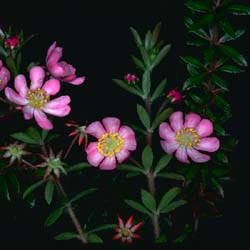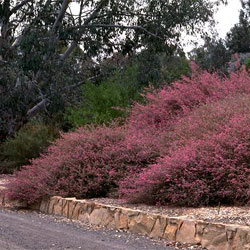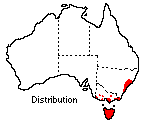Bauera rubioides
 |
 |
Dog Rose
Along with other famous Australian plants, Dog Rose (Bauera rubioides), is often pictured in books of the most striking and beautiful native species. It is popular in many native plant gardens and is not difficult to obtain, being easily raised from seed or cuttings.
Three species of this endemic genus are known, and these are to be found growing in the wild in only the eastern States of Australia and Tasmania. Two are in restricted mainland areas only, but B. rubioides is widespread throughout coastal regions and in mountains in moist places. In Tasmania, it grows in alpine areas, compact or prostrate where exposed and tall and lax in shade. For example, in forests it covers the undergrowth with a deep tangle of long thin stems, not prickly but impenetrable.
 Wiry
Scrub, Rose Heath and River Rose are other common names and indicate different
habitats with variations in character and size. Flower colours range from pure
white through delicate pinks to purple and shaded colours*.
Double-flowered plants are found occasionally. A plant that was once thought to be a dwarf form is now considered a species, B. microphylla.
Wiry
Scrub, Rose Heath and River Rose are other common names and indicate different
habitats with variations in character and size. Flower colours range from pure
white through delicate pinks to purple and shaded colours*.
Double-flowered plants are found occasionally. A plant that was once thought to be a dwarf form is now considered a species, B. microphylla.
If adequate moisture is provided an attraction of the shrub is its dainty, fresh appearance at all seasons and even into old age, due to continuous tip growth and light-green healthy foliage. Thin straight stems spring evenly from the plant down to ground level, eventually interlacing and hiding all aged branches. Hairs on stems and young leaves give a feathery effect.
For vigorous growth good watering is needed and in hot, dry conditions plants are sparse and poor, and may die. However, this is a resilient species and can recover from a small amount of live wood if watered in time.
Plants succeed in shade or with afternoon shade and if the plant is to be isolated, shelter from strong winds is needed to avoid the drying out of both roots and top. Lime-free light soils are suitable and coarse sand or old compost must be added to soil which is heavy or compacted. Thriving plants can be had in full sun with only moderate watering if the bed is mulched 5 cm deep with bark chips, compost or gravel to keep soil moisture and temperatures even. Such plants are sturdy with stiff branches straight or arching, and they frequently make dome-shaped ground covers.
Watered plants are bushy without trimming, though trimming can be done to turn the species into an informal hedge if desired. It can also be used in a large rock setting among natural boulders. Groupings for extensive ground covers can be seen in the Australian National Botanic Gardens. Large numbers of Bauera rubioides may be found in the Sydney Region Flora sections of the Gardens. Cold brings up attractive purple and bronze tints in the plants in open positions and no winter protection is necessary.
Growth rate in light soil and the open position is about 1 m high and 3 m across in eight years and the tallest example in these gardens is 1.5 m high at the same age.
The leaves are in horizontal whorls, widely spaced and shining in the sun. Each whorl consists of two opposite leaves each with three very even leaflets. They continue down the stems for the full length and are unblemished at all seasons.
The flowers are delicate shallow cups up to 2 cm across on 25 mm long stems. The number of petals varies from four to ten around a cluster of yellow-tipped stamens. There is a slight resemblance to a small wild rose, but Dog Rose is not closely related to the European Rosa canina.
Flowers cluster profusely in November towards the ends of branches and lateral stems, often facing down and showing neat reddish calyx lobes. Flowers open at least eight months of the year on a watered plant, and even in winter some branches can generally be found with a few flowers open.
Sprays of flowers last well in water, and as they are light in weight they
are perfect for shallow bowls.
Root-rot fungus has been the only disease noted in a wet year when this soil
fungus reached and infected species normally liking moisture. B. rubioides was badly affected with the typical die-back, but all signs of this were later
covered and plants grew away as if purposely trimmed for bushy growth. The species
is generally regarded as being resistant to root-rot fungus.
Of the other species of Bauera, Showy Bauera (B. sessiliflora)
is a beautiful shrub restricted to the Grampians area of Victoria. It is stiff
and upright, 1-1.5 m high, with open branching and magenta flowers close on
the stems.Young plants can sometimes be obtained from specialist dealers in
native plants. Moisture is essential for Showy Bauera in the garden. B. capitata is a small shrub of the central coast of NSW. It has been grown successfully
from cuttings but no success has been achieved in later cultivation. The species
is worth persevering with as it would make a delightful rockery plant.
Based on text by ANBG staff (1973)
*Horticultural Colur Chart, RHS,
London 1966, red-purple 74B
Name meaning: Bauera rubioidesBauera - after the Bauer brothers, two Austrians who assisted
early explorers as botanical painters; |
![An Australian Government Initiative [logo]](/images/austgovt_brown_90px.gif)

